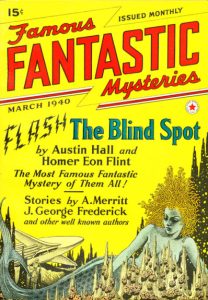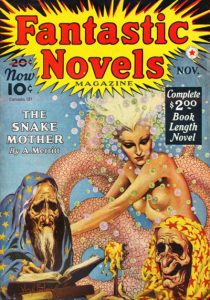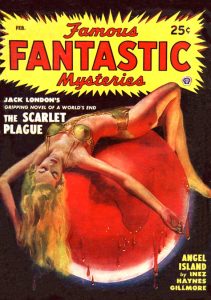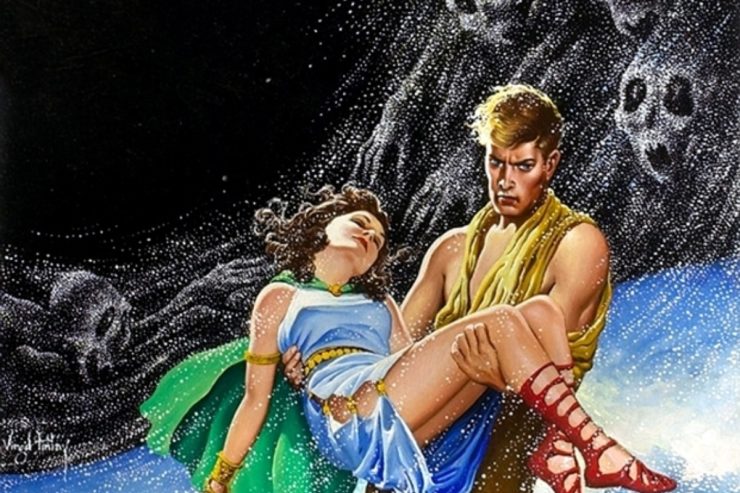Pulp magazines have influenced writers, artists, film directors, software developers, and countless others over the years. Our “Pulp History” articles focus on the rough-paper writers, editors, publishers, and artists who have inspired and continue to inspire the creators of the world’s popular culture.
 Who were the great pulp magazine editors? Bob Davis, Arthur Sullivant Hoffman, and Joseph T. Shaw readily come to mind.
Who were the great pulp magazine editors? Bob Davis, Arthur Sullivant Hoffman, and Joseph T. Shaw readily come to mind.
How about Daisy Bacon, the longtime editor of the best-selling pulp magazine of all time, Love Story Magazine?
What about Fanny Ellsworth, editor of Ranch Romances for over 25 years and Black Mask from 1936 to 1940?
And then there’s Mary Gnaedinger, born 125 years ago in Brooklyn, New York.
Like many pulp magazine editors, Gnaedinger managed many different titles during her twenty-year career. However, she is best known as the editor of Famous Fantastic Mysteries. She was at its helm from beginning to end, the first female lead editor of a science fiction magazine.
Gnaedinger was born on September 28, 1897, as Mary Catherine Jacobson. She attended the Columbia School of Journalism and, on September 22, 1919, she married Louis Beverley Nichol Gnaedinger. Her husband went on become a respected news editor and journalist with The New York Times and the Daily Mirror. The couple had one son, Arthur Beverley Gnaedinger. They later divorced.
As was the case with many female journalists of her time, Gnaedinger started as a society reporter for the Brooklyn Eagle. Afterward, sources say that she worked for E. F. Dutton Company before going to work for Graham Publications. In 1933, Graham assigned her to be the editor of Romantic Love Secrets Magazine. She held that position until June 1934.
Gnaedinger’s next known assignment was with the Frank A. Munsey Company, where she became an associate editor to Amita Fairgrieve on All-Story Love Stories.
 Between 1934 and 1939, it’s unclear as to whether Gnaedinger changed assignments within the Munsey company or other publishers, or she stayed with All-Story Love Stories. However, in 1939 Gnaedinger was chosen to be the editor of Famous Fantastic Mysteries, a magazine that initially focused on reprinting the best of fantasy and science fiction stories that had previously appeared in Munsey company magazines.
Between 1934 and 1939, it’s unclear as to whether Gnaedinger changed assignments within the Munsey company or other publishers, or she stayed with All-Story Love Stories. However, in 1939 Gnaedinger was chosen to be the editor of Famous Fantastic Mysteries, a magazine that initially focused on reprinting the best of fantasy and science fiction stories that had previously appeared in Munsey company magazines.
The fact that the publisher selected Gnaedinger to be editor is interesting because science fiction and fantasy weren’t necessarily genres that Gnaedinger was familiar with. But to Gnaedinger’s advantage, she followed the convention that had been established in other science fiction magazines by publishing stories that were popular with readers. She made it clear that this would be the policy in an editorial note found in the March 1940 issue of the new pulp magazine: “Each succeeding issue of Famous Fantastic Mysteries [will] conform further with the readers’ requests.”
An offshoot of this policy could be seen by the number of readers’ letters that appeared in each issue. It wasn’t unusual for twenty to thirty pages to be devoted to their letters.
 In 1940, Gnaedinger was given a spinoff, Fantastic Novels, a bi-monthly companion to Famous Fantastic Mysteries. It would primarily print longer works of fiction from the Munsey vaults — many by A. Merritt — and would use Virgil Finlay’s art extensively. Fantastic Novels ran for just five issues under the Munsey banner, ending with its April 1941 number.
In 1940, Gnaedinger was given a spinoff, Fantastic Novels, a bi-monthly companion to Famous Fantastic Mysteries. It would primarily print longer works of fiction from the Munsey vaults — many by A. Merritt — and would use Virgil Finlay’s art extensively. Fantastic Novels ran for just five issues under the Munsey banner, ending with its April 1941 number.
In 1942, the Frank A. Munsey company sold all of its pulp holdings to Popular Publications. Gnaedinger was kept on as editor of Famous Fantastic Mysteries.
The acquisition by Popular Publications brought a significant change to Famous Fantastic Mysteries. The magazine began to reprint more work from non-Munsey magazines and books long out of print. This change in policy gave Gnaedinger freedom to explore and use fiction never before printed in a pulp magazine. In her March 1943 editorial announcements, she writes, “In our opinion, this change, far from diminishing the quality of the book, should improve it. . . . Now we have the fantastic lore of the world from which to choose.”
Gnaedinger was also allowed to use new material to accompany the traditional reprints. The first piece of new fiction appeared in the December 1943 issue — Ray Bradbury’s short story, “King of the Gray Spaces.”
It would be another fifteen months before another piece of new fiction would appear in the magazine. “Before I Wake,” by Henry Kuttner, appeared in the March 1945 issue. Between 1945 and 1954, new material by A. Bertram Chandler (under the pseudonym George Whitley), Will F. Jenkins (under his Murray Leinster pseudonym), V. E. Thiessen, and others would appear. However, Gnaedinger would always stay faithful to the magazine’s original intent of reprinting fine fantastic mysteries and science fiction stories.
Like many other editors, Gnaedinger was assigned other magazines to edit during her tenure at Popular Publications. Most of these assignments were for new titles or titles on their last legs. According to some sources, her assignments were as varied as Sea Novels Magazine, Crack-Shot Western, Love Novels Magazine, Captain Zero, .44 Western, and Battle Birds, the latter of which she edited for its last year of existence. None of these came close to the longevity of Famous Fantastic Mysteries.
In 1948, Gnaedinger was asked to revive Fantastic Novels Magazine. Debuting with its March 1948 issue, it again reprinted longer works of fiction, primarily drawn from the Munsey vaults. This time, it ran for twenty issues, ending with its June 1951 number. Most of its covers were contributed by Lawrence Sterne Stevens.
Gnaedinger was also credited as editor of A. Merritt’s Fantasy Magazine, a reprint vehicle that began in December 1949 and ran for five issues with the last issue dated October 1950.
 Famous Fantastic Mysteries ceased publication in 1953, ending with its June issue. Gnaedinger’s editorship from its very first issue until the last was a rare feat for pulp editors in general, especially given that the magazine had two different owners over its fourteen-year lifespan.
Famous Fantastic Mysteries ceased publication in 1953, ending with its June issue. Gnaedinger’s editorship from its very first issue until the last was a rare feat for pulp editors in general, especially given that the magazine had two different owners over its fourteen-year lifespan.
Mary Gnaedinger died in 1976 at the age of 78. Over the last twenty years, her legacy has been appreciated in several publications, including Eric Leif Davin’s Partners in Wonder: Women and the Birth of Science Fiction, 1926-1965, Bobby Derie’s Deep Cuts in a Lovecraftian Vein, and Sisters of Tomorrow: The First Women of Science Fiction, edited by Lisa Yaszek and Patrick B. Sharp.
Mary Gnaedinger was the editor of Famous Fantastic Mysteries through its complete 81-issue run, working for the Frank A. Munsey Company, and later, for Popular Publications. The July 1942 issue pictured above — featuring front cover art by Virgil Finlay — includes Francis Stevens’ novella, “Serapion.” Like Gnaedinger, Stevens was a woman. Her real name was Gertrude Barrows Bennett.
Famous Fantastic Mysteries debuted in 1939 with its September-October number. Beginning with its sixth issue — dated March 1940 — the pulp began to feature a simple cover illustration, with the first by Virgil Finlay.
In 1940, Munsey launched Fantastic Novels, a bi-monthly companion to Famous Fantastic Mysteries. The first issue of the new magazine was dated November 1940 and also featured cover art by Virgil Finlay.
Although Finlay contributed over thirty covers to both magazines, Lawrence Sterne Stevens was the most prolific cover artist for Famous Fantastic Mysteries and Fantastic Novels. Pictured above is Lawrence’s cover art for the February 1949 number of the former. Other artists who contributed to the trio of Gnaedinger-edited science fiction pulps included Rafael DeSoto, Frank R. Paul, Norman Saunders, and Lawrence’s son, Peter Stevens.






